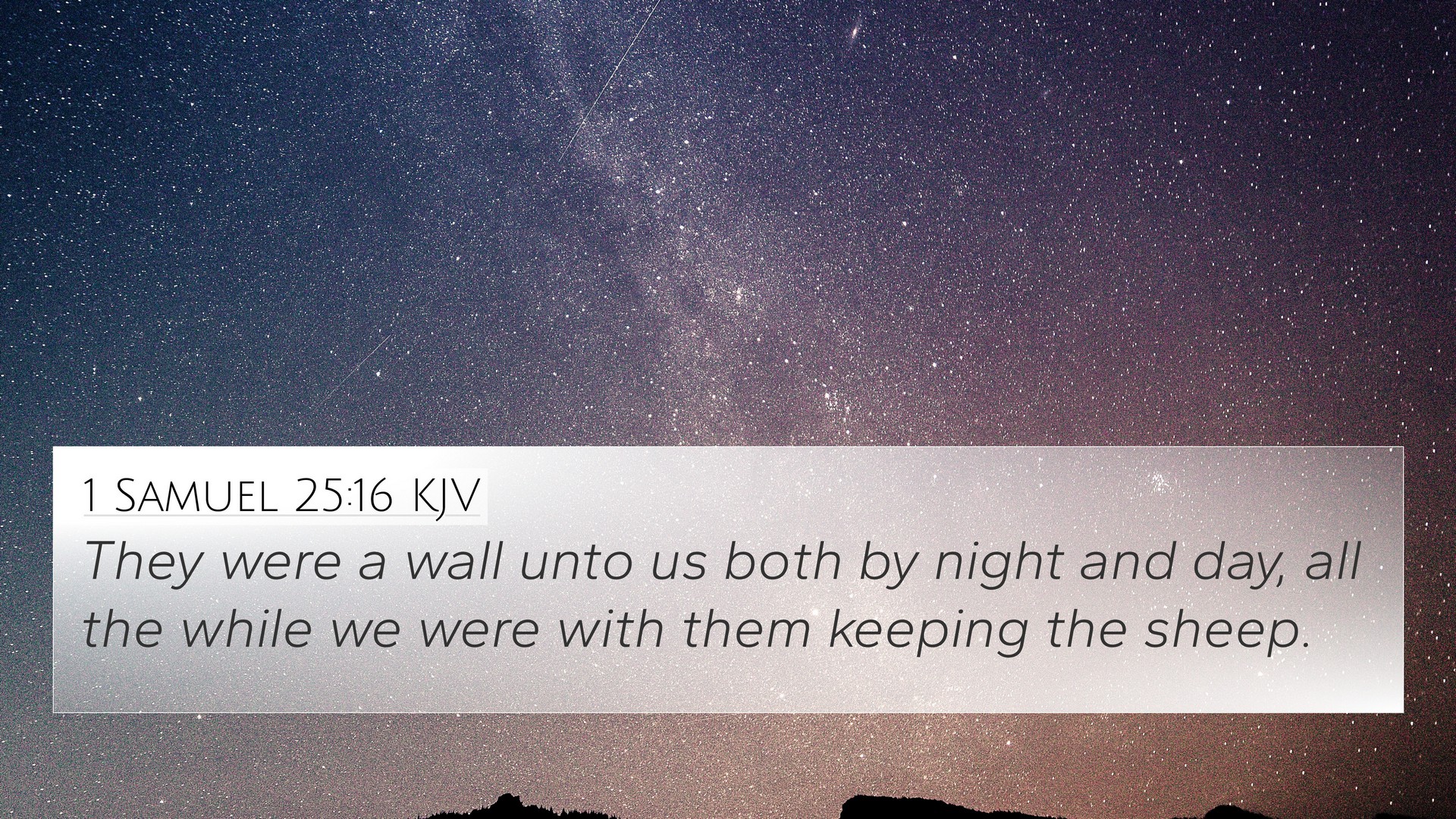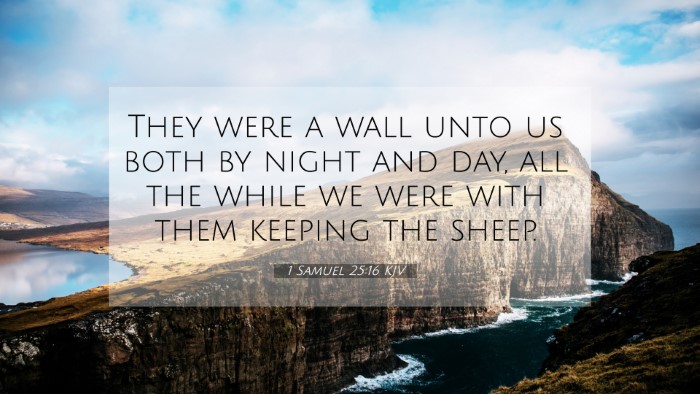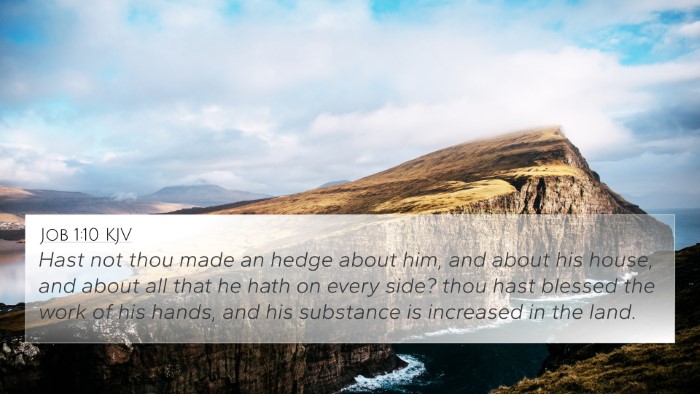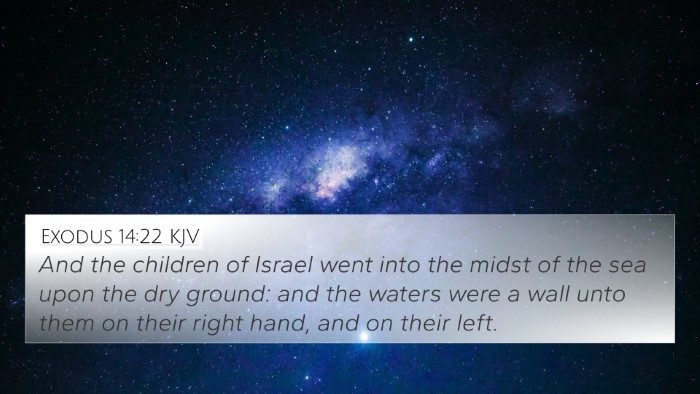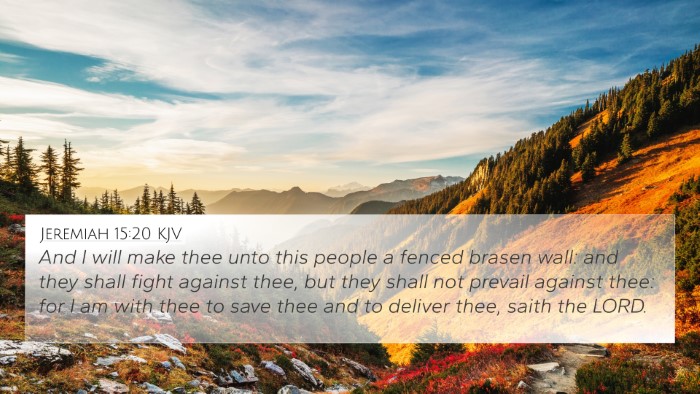Understanding 1 Samuel 25:16
Verse: "They were a wall unto us both by night and day, all the while we were with them keeping the sheep." (1 Samuel 25:16)
This verse reflects the protective role that Nabal's shepherds played while David and his men were in the vicinity. The verse conveys themes of loyalty, protection, and the reciprocal relationships that exist in community. Below, we delve into the interpretation and significance of this passage, drawing insights from notable public domain commentaries.
Commentary Insights
Matthew Henry's Commentary
Matthew Henry emphasizes the notion of protection in this verse, noting that the shepherds served as a "wall" for David and his men. This metaphor illustrates the strong safeguarding this group offered during times of vulnerability. Henry points out that in a time of peril, God often raises up protectors, illustrating divine provision through human means.
Albert Barnes' Notes
Albert Barnes highlights the humanitarian aspect of the shepherds’ actions. He interprets their role not only as protectors but also as guardians of hospitality. By helping David’s men, they displayed a commendable sense of loyalty in a time of unrest. Barnes asserts that this protection was essential given the context of David's fugitive status and the necessity of community support.
Adam Clarke's Commentary
Adam Clarke draws attention to the contrast between the shepherds’ loyalty and Nabal's foolishness. Clarke suggests that Nabal, as their master, failed to recognize the invaluable support provided by his servants. This contrast alludes to broader themes of wisdom and folly. Clarke highlights that even in difficult situations, those who act righteously are recorded in God's providence.
Thematic Connections and Cross-References
1 Samuel 25:16 offers rich thematic connections that can be cross-referenced with several other biblical passages:
- Psalm 121:7-8: God's protection is assured in this passage, paralleling the protection provided by the shepherds.
- Proverbs 17:17: Illustrates loyalty among friends, similar to the supportive role of Nabal's shepherds.
- Philippians 2:4: Calls for considering others' interests, which reflects the shepherds’ actions in supporting David.
- John 10:11: Jesus as the Good Shepherd represents ultimate protection, akin to the roles played by the shepherds in this verse.
- Matthew 7:7: The principle of seeking help is evident in David's reliance on the shepherds for protection.
- Exodus 2:17-19: The protective role of individuals in the narrative of Moses mirrors the support given to David.
- 1 Peter 5:2-3: Servant leadership is highlighted here, reflecting the loyalty seen among the shepherds.
Lessons and Applications
This verse, along with its commentaries, teaches valuable lessons on community and the importance of loyal relationships. The significance of nurturing and supporting one another in times of need is emphasized, showcasing a biblical principle that transcends cultural and historical backgrounds.
In a broader biblical context, examining the interrelationships of such verses can help illuminate the themes of protection, loyalty, and divine providence. Understanding these themes allows for deeper insights when engaging in Bible cross-reference guide studies, revealing how interconnected the scriptures truly are.
Utilizing Cross-Referencing Tools
For those looking to delve deeper into cross-referencing Bible study methods, several tools can assist:
- Bible Concordance: A helpful resource to identify themes and find where certain words or concepts appear.
- Bible Cross-Reference System: Systems that organize scripture for ease of study.
- Comprehensive Bible Cross-Reference Materials: Books and guides that provide detailed studies on themes across the Bible.
Exploring Further Themes
As we analyze the connections between Bible verses, we uncover a network of support and protection throughout scripture. Identifying how different narratives provide insight into mutual assistance can enhance one's understanding of biblical teachings and their application in life today.
Conclusion
In summary, 1 Samuel 25:16 serves as a poignant reminder of the value of loyalty and protection within a community. By examining this verse through the lens of various biblical commentaries and cross-references, we can appreciate the depth of its meaning and its relevance to both historical and contemporary contexts.
